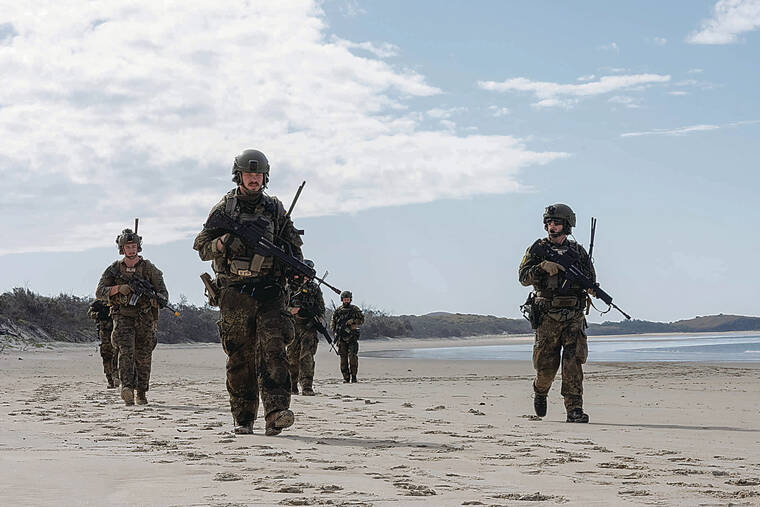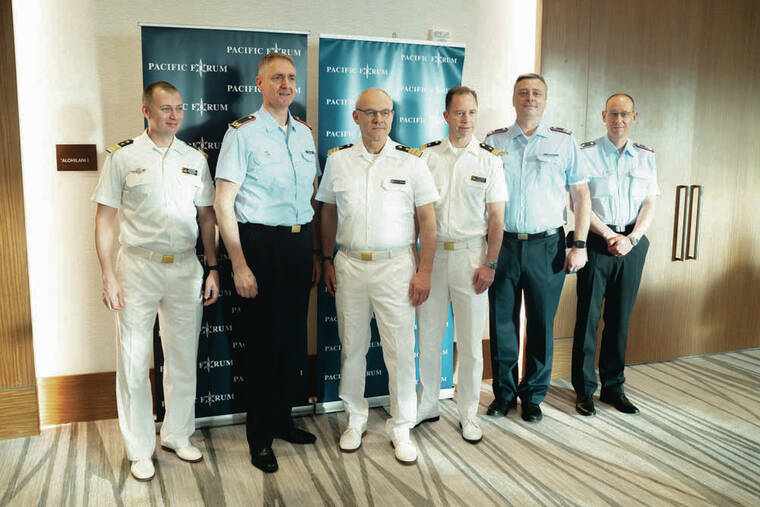German military coming to Hawaii

CPL. CHRISTOPHER W. ENGLAND / U.S. MARINE CORPS / AUG. 2
Sailors with 5th Platoon, German Coastal Operations Sea Battalion, and U.S. Marines with Battalion Landing Team 2/1, 31st Marine Expeditionary Unit, make their way to a rally point during an amphibious assault exercise at Stanage Bay, Australia.

COURTESY KELSIE HANCOCK, KM PHOTOGRAPHY
German navy chief Vice Adm. Jan Christian Kaack, third from left, posed for a photo during a January military affairs conference in Waikiki hosted by Honolulu think tank Pacific Forum.


The German military is planning a series of deployments to the Pacific this summer, and is looking at possibly setting up a permanent military liaison position in Hawaii at U.S. Indo-Pacific Command as it refines its regional strategy.
Germany for some time has been testing the waters for a return to the Pacific, deploying the Navy frigate FGS Bayern to the South China Sea in 2021 and sending small detachments of personnel to participate in exercises around the region. But this year the German Navy and Air Force will make their way to Hawaii for the biennial Rim of the Pacific Exercise, the world’s largest naval war game.
“Before we send people and forces into the region, we knew we needed knowledge of the region,” said German navy chief Vice Adm. Jan Christian Kaack. “We are building up liaison offices in Japan at (U.S. Navy) 7th Fleet and here at INDOPACOM (U.S. Indo-Pacific command). … Some are temporary, just for the deployment, and some will stay.”
German military officials had been quietly flying in and out of Honolulu in 2023 holding meetings with top U.S. military leaders, according to officials knowledgeable about the planning process. But since the new year German officials have become more vocal about their plans.
Kaack flew to Oahu in January along with a delegation of other German navy and air force officers to participate in a military affairs conference hosted by the Honolulu-based think tank Pacific Forum.
During the event he participated in a panel with U.S. Pacific Fleet commander Adm. Samuel Paparo, who is expected to soon take over U.S. Indo-Pacific command and lead all U.S. forces in the region.
Don't miss out on what's happening!
Stay in touch with breaking news, as it happens, conveniently in your email inbox. It's FREE!
Berlin in 2023 released its first China strategy, which called Beijing a “systemic rival” and advocated that Germany — Europe’s largest economy — work to reduce economic dependence on its largest trading partner.
“China has changed,” the document stated. “As a result of this and China’s political decisions, we need to change our approach to China.”
Kaack told the Honolulu Star-Advertiser that Beijing’s increasingly aggressive tactics in the South China Sea played a role in the shift in thinking.
Beijing has become locked in a series of disputes with neighboring countries over maritime navigation and territorial rights in the South China Sea, which serves as a critical trade route that more than one-third of all trade moves through. China has claimed the entire waterway over the objections of neighboring countries that also use resources and shipping routes in the sea.
A 2016 international court ruling in favor of the Philippines found that China’s claims have “no legal basis.” Beijing in turn has called the ruling “illegal” and has built military bases on disputed islands and atolls and attacked fishermen and other maritime workers from neighboring countries.
Kaack said the prospect of disruptions to free navigation in the Pacific is a major concern to Germany and other European countries. He also noted Chinese investment in port facilities in Europe as well as recent moves in the Arctic.
“China declaring itself a ‘near Arctic nation’ and operating up there, and now with the melting of the ice and Russia’s heavy involvement in the area and then this exploration by China, a lot of people woke up,” he said. “There’s a better understanding in German society now of how things are interconnected and that we should care.”
Germany has a complicated history in the Pacific region, once maintaining imperial holdings in China as well as ruling over the Northern Mariana Islands, Palau, the Marshall Islands, New Guinea, the Solomon Islands, Nauru and others until losing them to other imperial powers during World War I.
But German officials insist they want to return to the Pacific as friends to all nations in the region.
Kaack said, “I put a lot of effort during the last two years into discussions with partners in the area — Singapore and Malaysia, Indonesia, Philippines and others — to learn to listen a lot and to understand what their perception is and how they perceive us and what, from their perspective, are appropriate tasks for us.”
He said officials welcomed German participation in the region, on the condition that it isn’t through the auspices of NATO or the European Union and put Pacific relationships first.
“That was a clear, clear demand by most of the partners in the area,” said Kaack.
The German naval deployment will include two ships that will sail through the Suez Canal and make stops in India and Singapore before passing through the South China Sea. It will also make stops in Japan and participate in U.N. sanctions enforcement operations against North Korea. The ships will make their way to Hawaii for RIMPAC and then to San Diego and eventually through the Panama Canal to return to Europe.
The German air force deployment will be jointly conducted with the French and Spanish air forces starting in mid-June, flying from Europe to Alaska and on to Japan. In Japan the German group will split up, with half continuing on with the Spanish and French to Australia and the other half making their way to Hawaii for RIMPAC and then continuing to train with the Hawaii National Guard.
In January the German air force sent 15 personnel to Hawaii for advance planning of the deployment.
“This is the very first time we are coming to Hawaii with fighter jets,” said German air force spokesperson Lt. Col. Matthias Boehnke. “Together with our partners France, Spain, U.S.A. and other allies, this is a strong sign of solidarity and how important the Indo-Pacific region has become for peace in the world.”



